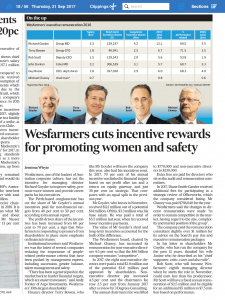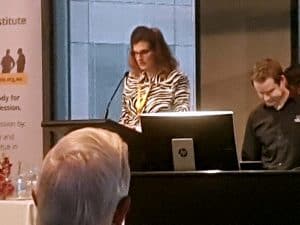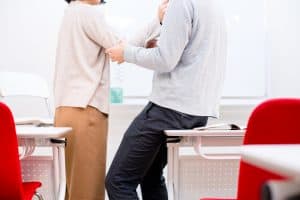 Today’s issue of the Australian Financial Review (AFR) contained an article that shows that the trend for companies and boards embracing their occupational health and safety (OHS) obligations is not uniform. The article “Wesfarmers cuts incentive rewards for promoting women and safety” reports that the Managing Director’s share of annual incentives paid for non-financial targets, which includes OHS, has been reduced from 40% to 30%. Continue reading “Financial targets preferred over OHS”
Today’s issue of the Australian Financial Review (AFR) contained an article that shows that the trend for companies and boards embracing their occupational health and safety (OHS) obligations is not uniform. The article “Wesfarmers cuts incentive rewards for promoting women and safety” reports that the Managing Director’s share of annual incentives paid for non-financial targets, which includes OHS, has been reduced from 40% to 30%. Continue reading “Financial targets preferred over OHS”
Category: executives
Marnie Williams talks of farm safety, responsibility and a radical future
 WorkSafe Victoria’s Executive Director, Health and Safety , Marnie Williams, has had a horrid week. Last Saturday, while being ill with a cold, she stood in for the Victorian Industrial Relations Minister at a Migrant Worker Forum, at which she was asked “what you gonna do about it?”. However she continues to make herself available, a crucial element for any leader of a regulatory agency.
WorkSafe Victoria’s Executive Director, Health and Safety , Marnie Williams, has had a horrid week. Last Saturday, while being ill with a cold, she stood in for the Victorian Industrial Relations Minister at a Migrant Worker Forum, at which she was asked “what you gonna do about it?”. However she continues to make herself available, a crucial element for any leader of a regulatory agency.
Farm Safety
A couple of days later at a safety conference run by the Safety Institute of Australia, SafetyAtWorkBlog accused WorkSafe of not doing enough about the safety of Victorian farmers. Williams rejected the accusation and forecast a new, and surprising, approach for agricultural safety.
Broken Windows seems to work
 I have written before about the use of Broken Windows theory in an occupational health and safety context. Earlier this year another OHS professional, Bryan McWhorter, wrote about his success in following this approach.
I have written before about the use of Broken Windows theory in an occupational health and safety context. Earlier this year another OHS professional, Bryan McWhorter, wrote about his success in following this approach.
One advantage of talking about this theory is that it applies a concept from outside the OHS field to affect worker and manager behaviours. A safety professional can use the theory’s origin story to show a different approach to safety management. It allows a rationalisation for enforcing safety on those “long hanging” hazards. Continue reading “Broken Windows seems to work”
SafetyConnect conference connects
 This week’s SAFETYconnect conference hosted by the NSCA Foundation in Sydney had a very good strike rate of interesting speakers on its first day. Only one speaker missed the safety mark – it was as if they had been handed a marketing presentation instead of safety and, regardless of the safety audience, give it anyway.
This week’s SAFETYconnect conference hosted by the NSCA Foundation in Sydney had a very good strike rate of interesting speakers on its first day. Only one speaker missed the safety mark – it was as if they had been handed a marketing presentation instead of safety and, regardless of the safety audience, give it anyway.
This conference was notable for the way that the ‘safety differently’/Safety II movement has moved into mainstream safety management. The most obvious example of this was a presentation by QantasLink.
University sexual assault – an OHS perspective
 The community and media responses to the Australian Human Rights Commission report into sexual assault and harassment in Australian universities continue but until the Australian Government responds, it is unclear how the risks will be reduced, particularly as many members of the current Federal Government have been openly hostile to the AHRC and its previous Commissioner, Gillian Triggs. After having rubbished the Commissioner and the institution, how will the government respond?
The community and media responses to the Australian Human Rights Commission report into sexual assault and harassment in Australian universities continue but until the Australian Government responds, it is unclear how the risks will be reduced, particularly as many members of the current Federal Government have been openly hostile to the AHRC and its previous Commissioner, Gillian Triggs. After having rubbished the Commissioner and the institution, how will the government respond?
Following on from the very popular SafetyAtWorkBlog article about the report yesterday, it is worth looking at the AHRC recommendations in the occupational health and safety (OHS) context.
It should be noted that OHS places the principal responsibility on the employer, in this instance, the universities and the Vice-Chancellors. Some have already started to call on the government to play a role, with implications that it should be leading the change: Continue reading “University sexual assault – an OHS perspective”
Cultural change programs can mask the need for change
 Occupational health and safety (OHS) is increasingly being touted as an integral part of a company’s organisational culture. Sometime this is described as a workplace, or safety, culture. If OHS is to be considered thus, it is important to understand other cultural perspectives. One of the most prominent in Australia, at the moment, is the culture of the banking sector.
Occupational health and safety (OHS) is increasingly being touted as an integral part of a company’s organisational culture. Sometime this is described as a workplace, or safety, culture. If OHS is to be considered thus, it is important to understand other cultural perspectives. One of the most prominent in Australia, at the moment, is the culture of the banking sector.
Psychology, Leadership and Jonathan Lincolne
 Episode 47 of Andrew Barrett’s Safety On Tap podcast consisted of an interview with Jonathan Lincolne of Pockets of Brilliance. Several comments are of note.
Episode 47 of Andrew Barrett’s Safety On Tap podcast consisted of an interview with Jonathan Lincolne of Pockets of Brilliance. Several comments are of note.
Psychology
Around the 47 minute mark, Lincolne is asked about the level of psychological knowledge that the occupational health and safety (OHS) professionals should possess. Lincolne refreshingly describes himself as a skeptic about a lot of the recent psychological discussion, particularly the promotion of neuroscience.
